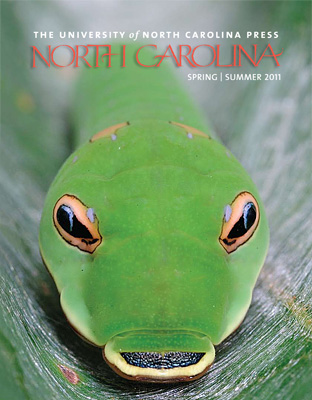The cover of the spring 2011 catalog of new books from UNC Press features a photograph from Wild North Carolina of a palamedes swallowtail caterpillar preparing to pupate on a red bay leaf.
These are common butterflies in pocosins or other areas that have their favorite host plants. The caterpillars feed only on plants in the laurel family. In North Carolina that means mostly red bay (Persea borbonia) but could also include swamp bay (Persea palustris) and possibly sassafras (Sassafras albidum).
The caterpillars eat red bay leaves almost exclusively and even wrap themselves inside red bay leaves for protection when they are ready to pupate. The photograph shows a caterpillar as it begins to use silk to curl a red bay leaf around itself.
Although this is one of the most common butterflies in the coastal plain of North Carolina, it is threatened by an introduced disease that is killing its host plant. Red bay wilt disease is caused by an introduced fungus and beetle from Asia first detected in Georgia in 2002. The beetle and fungus have since spread into Florida and South Carolina.
I wanted to include a photograph of one of these caterpillars in the chapter on pocosins to make these connections, but finding a caterpillar in the wild is not easy. I was in an area of Juniper Creek near the Green Swamp with plenty of red bay trees but I had no idea how I was going to find a caterpillar. Then I saw an adult fly by as if it had some place important to go, so I followed it. I could not keep up in the thick vegetation and soon lost sight of it. Then another flew by heading in the same direction so I followed it until I lost it. A third came and I followed it a little further when I saw it land on a particularly healthy and sunlit red bay tree. It danced around the leaves as I approached and I guessed it might be laying eggs. I decided this was as good a tree as any to search for caterpillars. I looked for about 10 minutes, carefully examining one leaf after another, until I noticed one backlit leaf with a caterpillar silhouette showing through. I looked on the other side of the leaf and there it was; a full grown caterpillar almost ready to pupate!
These caterpillars have a pattern on their backs that looks like a face, to fool predators I presume. I decided on a perspective that maximized the face illusion and went to work setting up the camera. There are two spots on the back that look like eyes and a hard plate covering the head that looks like a mouth. One thing I always pay attention to when photographing animals, especially animals with dark eyes, is the reflection on the eye. Without a reflection a dark eye can look like a black hole. As I looked through the camera I noticed the wonderful reflections on the eyes but then I realized these are not really eyes and these reflections don’t change as I move the camera! That is when it hit me just how amazing this face illusion is! Those are not reflections at all; it is part of the pattern designed to look like the reflection on an eye! For a moment I forgot about taking photographs and just marveled at the incomprehensible perfection of this tiny miracle.


Hi David, gosh long time since I’ve seen a post on your blog! Love the post and your photography, as always is superb… you do just get better and better! Hope all is well with you and you are keeping busy with the environment and photography!
Hugs for now,
Beth P